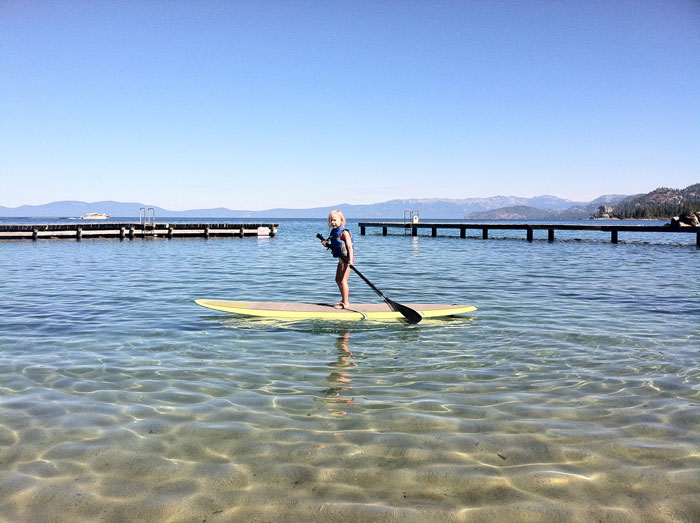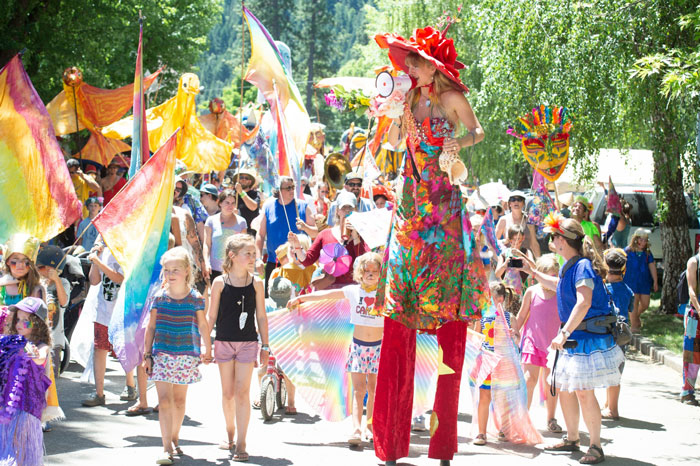- California Enduro Series Announces 2024 Schedule - 11/19/2023
- ASHLAND MOUNTAIN CHALLENGE 2023 – CES RACE REPORT - 10/04/2023
- China Peak Enduro 2023 – CES Race Report - 09/04/2023
Whether passenger or pilot, tips for introducing kids to paddleboarding
By Pete Gauvin

Young SUP’er on her way to circumnavigating Lake Tahoe, or a pint-sized portion there of. Photo by Cathy Claesson
Kayaks and canoes have long been the vehicle of choice when venturing out on the water with kids. But with the explosive growth of stand-up paddling – the fastest growing outdoor sport over the past five years – more and more parents are introducing kids to paddling on boards.
Paddleboarding is an excellent way for parents to get outdoors with children, get some low-impact exercise, soak up a good dose of fun, and teach tykes about water safety, paddle skills and the marine environment.
Here are some guidelines and suggestions for getting out for a little SUPin’ with little ones, whether riding on the board with you or going solo on their own board.
Toddlers – Along for the Ride: I started paddling with my daughter when she was two. With her toddler’s PFD and sun hat affixed, I’d sit her on the front of my board just in front of the grab handle a foot or two, always in sight, where she could hold on to the deck rigging or lie on her belly.
On a big touring-style board or inflatable 12’6 SUP, it was a dry ride, though she liked to drag her fingers through the water as I paddled. I’d keep the paddles short, generally under an hour, but long enough to put in a few miles on calm water. A couple times when she was feeling especially clingy, I’d paddle sitting down with her between my legs until she felt comfortable and the experience absorbed her apprehensions.
These outings provided interesting stimulation for her and needed outdoor exercise for me without the need for a babysitter.
With your toddler in front of you, be extra careful when paddling in shallow water or through kelp which can grab your fin and send you down on top of your child. When in doubt, paddle from your knees.
Groms – SUPin’ Solo: As a general rule, based on the experience of rental oufits, age 7 or 8 is the range in which kids are ready and able to start paddling on boards themselves – with supervision and in protected water. That said, it’s not uncommon to see kids as young as 5 or 6, or even younger, piloting their own pint-sized board.
Consider things like your child’s comfort in and around water, their ability to receive a little instruction and their motor-skill development before putting he or she on the water to fend for themselves. Of course, calm, protected water with little wind ensures a much greater chance of success and encouragement for the future.
Start on flat water, and keep them near shore, but far enough from docks and rocks and boats and things that can knock them off their feet with the slightest bump. At the beach, venture into the waves only when under a when under a couple feet and away from crowds.
Keep instruction lean and simple; do not overwhelm them with technique tips and how-to drills. Emphasize no more than three skills or points at a time. The bare basics are: forward stroke (reach forward, plant the blade, pull), applying brakes (on the front of the blade, backstroke from hip forward), and turning (backstroke, paddling on one side). Show them and practice on land first. Once on the water, limit the coaching and let them make errors; it’s the quickest way to learn.
Beware of the wind. Stand-up paddling is challenging in windy conditions for anyone, especially for children. If there’s a chance the wind may come up, have them stay close to the dock or beach, or make certain they head up wind first so you know they can get back when they turnaround. Paddling from the knees is the most effective technique for combating a stiff headwind.
Gear and Boards: Kids should wear active flotation (foam vests, appropriate for their weight range), not the popular CO2-inflated belt-pack PFDs, which are legal only for adults. More important, they should wear a leash that keeps them with their board should they fall off.
The most important piece of gear to ensure SUP success for your child is an appropriately sized paddle. Handing them an adult-sized paddle with a long shaft and overly large blade, particularly if it’s heavy, will make learning exceedingly awkward and challenging.
If you’re in the market for either an adult or children’s SUP board, consider inflatables as well as hard-shell boards. Today’s inflatables pack a lot of performance and convenience into a go-anywhere package that can withstand lots of abuse and won’t bite back as hard should a bit of childhood roughhousing ensue. A bonk to the head with an inflatable is less likely to send your little one to the ER. And you’re less likely to need a ding repair shop for the board if they run it up on the rocks or ram it into a dock.
All things bound to happen in the evolution of a young stand-up paddleboarder.
Former ASJ Editor Pete Gauvin is a certified stand-up paddle instructor with 101 Surf Sports in San Rafael, www.101surfsports.com, and the father of a four-year old girl who still prefers play time with pink unicorns to paddleboarding.












